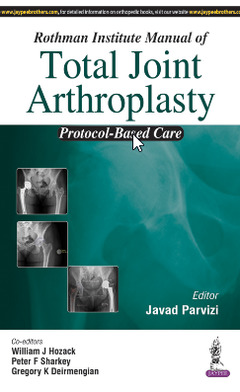Description
Rothman Institute Manual of Total Joint Arthroplasty
Protocol-Based Care
Authors: Parvizi Javed, Hozack William J, Sharkey Peter F, Deirmengian Gregory K
Language: English
Subject for Rothman Institute Manual of Total Joint Arthroplasty:
Approximative price 77.14 €
In Print (Delivery period: 14 days).
Add to cart680 p. · 21.5x27.9 cm · Hardback
Description
/li>Contents
/li>Readership
/li>Biography
/li>
This book is a complete guide to total joint arthroplasty for orthopaedic surgeons presented as a collection of key protocols for surgery.
Divided into four sections, the text begins with preoperative considerations, covering patient evaluation, clinical examination, indications, and implant selection. The following section provides step by step guidance on the complete range of arthroplasty techniques and associated procedures.
Section three covers postoperative management such as wound care, transfusions, physical therapy, medication, and much more. The final chapters in the book discuss the management of numerous potential complications.
Edited by an internationally recognised team of experts, led by Javad Parvizi from the renowned Rothman Institute in Philadelphia, this comprehensive guide is enhanced by surgical images and diagrams to assist learning.
Key points
- Comprehensive guide to total joint arthroplasty for orthopaedic surgeons
- Presented as collection of key protocols for surgical procedures
- Provides step by step guidance from preoperative considerations, to surgical techniques, postoperative management, and complications
- Edited by internationally recognised experts from the Rothman Institute
Section 1: Preoperative
- Indications and Contraindications for Total Joint Arthroplasty
- Preoperative Radiographic Evaluation
- Consent: When and Where?
- Perioperative Patient Evaluation
- Additional Testing and Preoperative Consultation
- Management of Preoperative Medications
- Prehabilitation for Total Knee Arthroplasty and Total Hip Arthroplasty
- Clinical Examination of the Hip
- Clinical Examination of the Knee
- Preoperative Nutritional Optimization
- Smoking Cessation
- Perioperative Optimization of the Diabetic Patient
- Optimization of the Patient with Cardiopathy
- Optimization of the Renal Failure Patient
- Optimization of Chronic Obstructive Pulmonary Disease
- Optimization of Sleep Apnea
- Optimization of Anemia
- Preadmission Testing and Preoperative Consultation
- Preoperative Templating
- Implant Selection for Total Hip Arthroplasty
- Implant Choices in Total Knee Arthroplasty
Section 2: Perioperative
- Intraoperative Deep Vein Thrombosis Prophylaxis
- Multimodal Pain Management in Total Knee Arthroplasty
- Multimodal Pain Management in Total Hip Arthroplasty
- Peripheral and Neuraxial Blocks for Analgesia After Total Joint Arthroplasty: Indications and Techniques
- Preoperative Antibiotics
- Tranexamic Acid
- Intraoperative Steroid Administration
- Anesthetic Techniques in Total Joint Arthroplasty: Neuraxial Anesthesia
- Anesthetic Techniques in Total Joint Arthroplasty: General Anesthesia
- Skin Preparation
- Tourniquet Use in Total Knee Arthroplasty
- Operating Room Universal Precautions
- Surgical Hand Antisepsis Practices
- Operating Room Traffic
- Draping
- Direct Anterior Approach to Total Hip Arthroplasty
- Surgical Approaches to Hip: Direct Lateral
- Surgical Approaches: Posterior Hip
- Medial Parapatellar Approach for Total Knee Arthroplasty
- Subvastus and Midvastus Approach to the Knee
- Unicompartmental Knee Arthroplasty
- Patellofemoral Arthroplasty
- Total Hip Arthroplasty in Patients with Metabolic Bone Disease
- Total Hip Arthroplasty in Protrusio Acetabuli
- Total Hip Arthroplasty in Patients with Proximal Femoral Deformity
- Total Knee Arthroplasty for Patients with Severe Deformity
- Antibiotic Cement
- Computer-Assisted Total Knee Arthroplasty
- Patient-Specific Instrumentation
- Management of Vascular Complications: Hip
- Management of Vascular Complications in Total Knee Arthroplasty
- Surgical Drains
- Wound Closure
- Urinary Catheter in Primary Total Joint Arthroplasty
- Surgical Dressing in Total Joint Arthroplasty
- Postoperative X-rays (Hips and Knees)
- Heterotopic Ossification Prevention
Section 3: Postoperative Management
- Operative Note Dictation in Total Joint Arthroplasty
- Postoperative Fluid Management
- Venous Thromboembolism Prophylaxis for Total Joint Arthroplasty
- Risk Stratification for Venous Thromboembolism After Total Joint Arthroplasty
- Sleeping Aids After Total Joint Arthroplasty
- Postoperative Gastrointestinal Complications
- Routine Postoperative Laboratory Investigations
- Postoperative Antibiotic Prophylaxis
- Wound Care and Dressings
- Transfusions
- Fever Management
- Oxygen Desaturation Management
- Altered Mental Status and Postoperative Neurologic Abnormalities
- Weight-Bearing After Total Joint Arthroplasty
- Management of Urinary Retention After Total Joint Arthroplasty
- Management of Cardiac Arrhythmias
- Management of Diagnosed Deep Vein Thrombosis
- Management of Diagnosed Pulmonary Embolism
- Physical and Occupational Therapy After Total Knee Arthroplasty
- Physical and Occupational Therapy After Total Hip Arthroplasty
- Discharge Destination: Rehabilitation vs Home
- Home Physical Therapy After Total Joint Arthroplasty
- Discharge Pain Medications
- Activity Modification After Total Hip Arthroplasty
- Continuous Passive Motion for Rehabilitation After Total Knee Arthroplasty
- Follow-Up Times and Goals After Total Joint Arthroplasty
- Antibiotic Prophylaxis for Minor Procedures After Total Joint Arthroplasty
- Restarting Medications
Section 4 Complications
- Management of Wound Drainage After Total Joint Arthroplasty
- Postoperative Blister
- Postoperative Infection Investigation
- Management of Acute Periprosthetic Hip Infection
- Management of Acute Infection: Knee
- Management of Chronic Infection
- Management of Dislocated Hip: Early vs Late
- Management of Intraoperative Fractures During Total Hip Arthroplasty
- Management of Intraoperative Fractures During Total Knee Arthroplasty
- Management of Periprosthetic Hip Fractures
- Management of Postoperative Periprosthetic Knee Fractures
- Management of the Swollen Limb in the Early Postoperative Patient
- Management of Residual Leg Length Discrepancy After Total Hip Arthroplasty
- Management of Stiff Knee After Total Knee Arthroplasty
- Management of Painful Total Knee Arthroplasty
- Management of Neurologic Deficit: Hip
- Management of Neurologic Deficit: Knee
Javad Parvizi MD FRCS
Professor, Department of Orthopaedic Surgery, Rothman Institute, Thomas Jefferson University, Philadelphia, Pennsylvania, USA
William J Hozack MD
Resident, Department of Orthopaedic Surgery, Rothman Institute, Thomas Jefferson University, Philadelphia, Pennsylvania, USA
Peter F Sharkey MD
Professor, Department of Orthopaedics, Riddle Memorial Hospital, Media, Pennsylvania, USA
Gregory K Deirmengian MD
Associate Professor, Department of Orthopaedic Surgery, Sydney Kimmel Medical College, Thomas Jefferson University, Philadelphia, Pennsylvania, USA



